| 1 | The greenest of all boas |
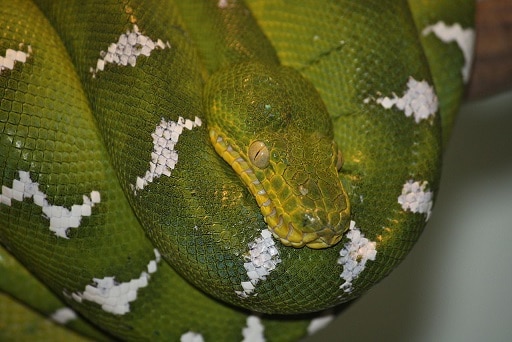
If you ever needed to infiltrate the Amazon rainforest by stealth, which colours would you choose for camouflage? The ultimate choice would have to be bright green to disguise yourself against the foliage, with small white or grey spots to mimic the beams of light shining through the canopies.
This pattern is exactly what the 2 metre long emerald tree boa has evolved. This snake belongs to the same boa (boid) family as boa constrictors, but rather than beige and brown, the emerald tree boa is almost exclusively a light yet rich shade of green. It has thin stripes or patches of white on its body, which cover a small surface area. The species is almost entirely green-white, except for a 3cm blue-black mark under its chin, to mark the point where its mouth stretches to swallow prey.
This species’ colours wouldn’t be out of place in a McDonald’s ball pit, but up close, it looks like a savage predator. The emerald tree boa has a thin neck followed by a large, bulky head. It has vertical pupils, and its hungry, crinkled face has strong hints of crocodile, which makes sense, as boas are a more primitive family of snake (like pythons).
| 2 | Exclusively a rainforest dweller |
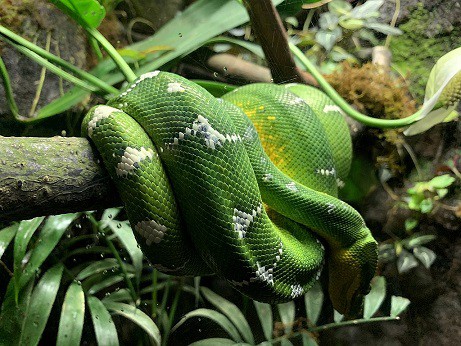
The epicentre of the emerald tree boa’s range lies in Brazil, but to the southwest their range crosses into Peru and Bolivia. To the northwest, it crosses into Ecuador, Venezuela, Columbia, Guyana, Suriname, and French Guinea. This coincides perfectly with the humid, ever twisting expanses of the Amazon rainforest.
Unlike the surprisingly flexible boa constrictor, the emerald tree boa is an exclusive rainforest dweller. You’ll never find them eating rodents on a sugar plantation or curled up in your toilet at 1am at night. They can be found at elevations of 0 to 1000 metres, but the key is rainfall; emerald tree boas require an annual precipitation total of 1500mm or more.
Emerald tree boas live a life surrounded by swarms of insects, bright-coloured lizards, and small scurrying rodents making rustling sounds through the bushes. They spend their days curled up on branches, particularly mid height branches 2.5 metres above ground. Its favourite branches of all are ones overhanging small bodies of water (which probably isn’t water you’d want to drink from).
| 3 | A sloth in serpent form |
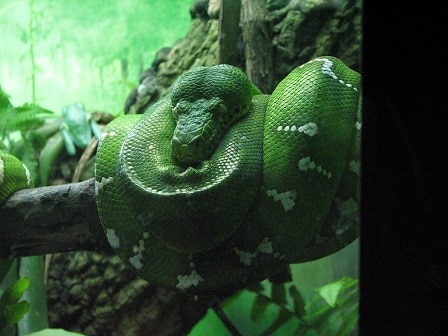
This bright green snake is an ambush predator, and consequently, it can go for months at a time without eating. The corn snake of the USA needs to eat every 10 days, but the emerald tree boa has one of the slowest metabolisms in the snake kingdom. This is the serpent equivalent of a sloth, spending almost all its life coiled around a tree branch, which it grips using its unnaturally strong prehensile tail.
By day, the snake rests its head in the centre of its tightly wrapped coils, like a comfortable seat of expensive green cushions. Night-time is hunting time, when they extend their green heads downwards to the forest floor to search for scurrying rodents. The emerald tree boa swings slowly like a vine, keeping its body totally rigid and still. They occasionally seize prey running along their branches, but take the vast majority of their prey from the forest floor.
Unlike the more active blunt-headed tree snake nearby, this species is hardly ever spotted on the ground. When they are, it’s usually a sign of severe distress, such as fleeing a hungry crested eagle.
| 4 | Finely tuned for eating mammals |
The emerald tree boa was first described in 1758 by Carl Linnaeus, and were long believed to feed exclusively on birds. In 1993 though, Dr Joel Hendersen analysed the stomach contents of 11 wild emerald tree boas. 10 contained small mammals, many of which were the rice rat. This rodent also dwells in jungle trees, running along the branches skittishly, and is now believed to be the emerald tree boa’s main prey. A young boa had a lizard in its stomach which was probably a turnip-tailed gecko.
Their mammal-munching habits make perfect sense when you analyse their vision, because emerald tree boas have 42 eyes. Not literally, but the species possesses 40 heat sensing pits behind its 2 regular eyes. These pits provide minute infrared sensing, and are found in many snake species, but this number is higher than almost all fellow boas. Herpetologists have noticed how these sensors are poor at hunting flying birds, or even nesting ones. Birds are ectothermic creatures, but give off significantly less body heat than mammals.
| 5 | Ultra efficient teeth |
The emerald tree boa is well known for its brutal front teeth, which hold the global record for most disproportionate length in non-venomous snakes. The goal is to grip its prey without shifting much from their branches, but the workings are more subtle than a pierce and hold manoeuvre.
The emerald tree boa has front teeth pointing highly posteriorly (backwards). The angle between the roof of the mouth is smaller than any other boa species. The teeth aren’t pointing straight to the floor like human teeth, and this allows the emerald tree boa to slide its entire mouth over a struggling rat and hold it in place with an unbreakable iron clamp. The sharp fangs only penetrate the rat’s skin if it thrashes its body too much.
Being lazy and loving it, the emerald tree boa needs to conserve valuable energy. It depletes a portion in the initial rapid strike, and pursuing an escaping rat down a tree trunk and across the thick rainforest would be way too much to cope with.
| 6 | Uses gravity to its advantage |
The emerald tree boa is a constrictor, squeezing its prey’s blood vessels and asphyxiating them, rendering them unconscious within seconds. They almost always squeeze with their muscular upper body, which can move around the air freely while the lower half remains glued to a branch. Next, they use one of their special tricks: swallowing the deceased prey with their head moving upwards, to take advantage of gravity.
Despite these hunting instincts, the emerald tree boa isn’t quite top of the food chain. There’s one feathered friend who has objections to that: the crested eagle (picture above), a large white bird with a wingspan of a whopping 6 feet. This species has multiple confirmed snakes in its diet, and has been witnessed taking a chunk out of team emerald boa several times. In fact, the first image on the species’ wikipedia page shows it holding an emerald tree boa while sitting on a leafy branch and looking proud of its catch.
| 7 | Newborns are red instead |
Mothers emerald tree boas birth to live young, usually 6-12, and occasionally as much as 20. This is significantly lower than the boa constrictor, which produces an entire football team of 10-64 babies.
After birth, newborns are a completely different colour. They’re a squelchy-looking red instead, not brick red or a bright neon red, but red like a freshly cut steak. The reason is unknown, but it’s believed that younglings mimic venomous rainforest snakes, until it becomes more advantageous as adults to utilise camouflage.
The change begins at 6-12 months, when green scales appear at their sides and slowly spread. Newborns only have small white marks on their posterior zone, but the moment the green scales first appear, the white ones begin to appear closer to the head. Next, the head shifts from orange to a green-orange colour, followed soon after by the body.
The last stage is a skin shedding, which finally removes all traces of orange, before the newborn emerges in all green and white, like a phoenix from the ashes. This colour transformation can take as little as 6 weeks.
| 8 | Ultra patient, never in a rush |
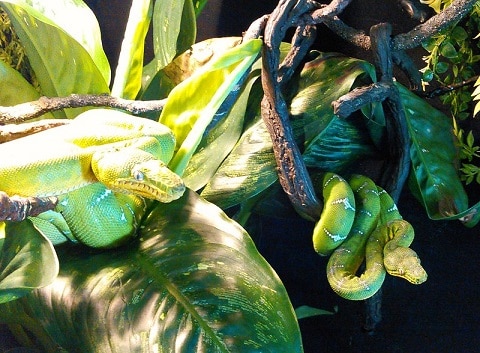
Emerald tree boas usually remain completely still when explorers approach them. They don’t sweep their upper bodies up and bare their viciously long front teeth, and they never flee along the branch. They remain still until the very second they’re touched, at which point they burst into life, coiling around the aggressor’s arms with surprising speed, and constricting his bones and muscles with all its might.
This only causes mild pain, and afterwards, the emerald tree boa usually calms down and accepts captivity. They can live for 20 years in good conditions, and their lazy lifestyles translate well to a reptile enclosure.
Introducing another male is another story, particularly if there’s a female involved as well. Such a faceoff inevitable leads towards a full scale duel. Instead of wrestling upright like a cobra, the dominant male usually wraps itself around the rival male’s neck, at which point it submits. This species is all about the wrapping in love as well, as males curl their tales around the female’s tail when courting.
| 9 | The northern morph |
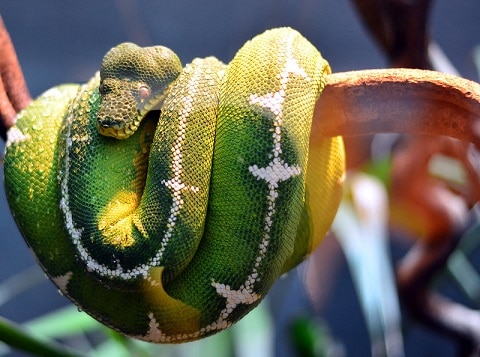
Officially, the emerald tree boa is one homogenous species, but many herpetologists are convinced that it’s several closely related ones. For example, the Guinea shield is a major section of the Amazon rainforest that includes northern Brazil and the countries immediately above (Suriname, Guyana). This is where the typical green emerald boa lives, but those in the Amazon basin further south tend to be much larger, recaching 2.1-2.7 metres compared to the average of 1.8m. The white markings are sometimes an unbroken white line rather than separated lightning bolt symbols, and they also have a more docile personality.
Down in northern Peru, the emerald tree boas are significantly darker, which makes the white patches stand out all the more strongly. These patches have more of a tear drop shape. The Amazon basin version sometimes has small black marks bordering the white, and the scales on their snouts are significantly smaller.
In 5 years or less, the emerald tee boa could be divided into several new species, with one or two becoming endangered overnight.
| 10 | The emerald tree boa goes viral |
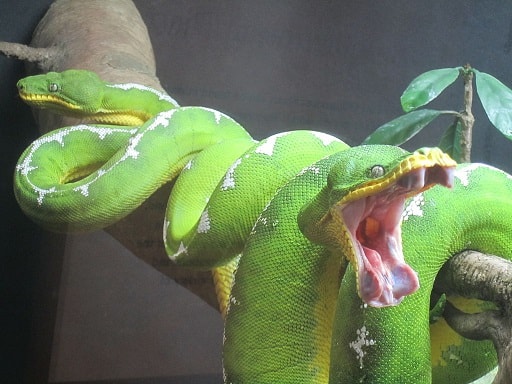
2021 was the year when the emerald tree boa became famous on reddit and youtube, with a video showing a captive specimen doing nothing but yawning in extreme slow motion. All the folds and vicious fangs of its mouth were laid bare, and one youtube edit had the music of Yoshi from the Super Mario franchise superimposed on it.
This video led to great uncertainty within society, as people weren’t certain whether to be charmed or terrified. The snake was yawning as peacefully as any lazy person on a Saturday morning, yet its teeth were as long as daggers. Some speculated that they’d discovered the original inspiration to Predator from 1986, specifically the ending scenes where the creature is finally unmasked before detonating itself.
This wasn’t the first viral video, as one from 2020 showed a captive emerald tree boa examining a tank full of fish. This video showed the classic movements from branch position, with its upper body swaying around stiffly, except that its body was wrapped around a plastic frame instead. Fish aren’t known to be part of the species’ rainforest diet, but this snake looked extremely curious about them.
| 11 | Crocodilian assaults |
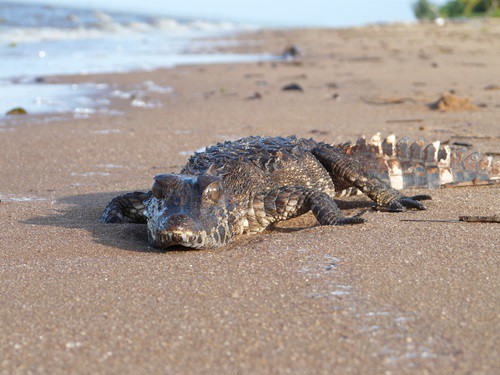
Emerald tree boas aren’t safe in their rainforests, as they’re even under attack from the crocodilian world. The species is the smooth-fronted caiman, native to French Guiana and averaging at 1.2-1.6 metres long, with the a particularly hungry crocodile smirk on its face.
In April 2014, scientists were observing the River Arataye in Nature Reserve Les Nouragues, when a caiman appeared from underwater near the sandy bank. It had a whole emerald tree boa in its jaws, which was either dead or barely alive. There was no clue as to how it acquired the snake. The smooth-fronted caiman then disappeared underwater, emerald tree boa still in its jaws, leaving the scientists to wonder.
Compared to a Nile crocodile, this caiman prefers shadowy vegetated areas. They lurk in obscure rainforest rivers and are rarely visible by day. Even when they stray 100 metres from a river, they still stay in tangled vegetation where the sun’s rays only feebly penetrate. This was the first record of a smooth-fronted caiman preying on an emerald tree boa. This crafty crocodilian must have got lucky and grabbed the snake on a rare occasion it strayed to the ground.
